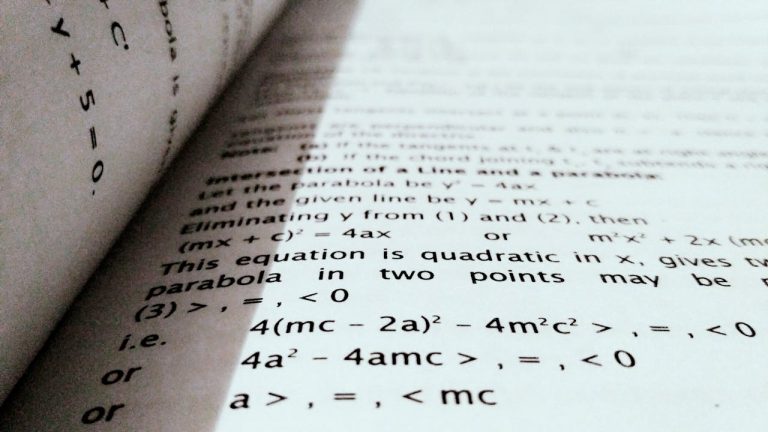As someone deeply familiar with the complexities of the International Baccalaureate (IB) program, I’ve grown to appreciate both the challenges and the opportunities presented by the Internal Assessment (IA). In this article, I aim to clarify the grading boundaries for the Math IA, offering clear and practical guidance for IB students to achieve excellence in this essential part of their diploma.
Understanding Math IA Grading
What exactly is a Math IA? Well, it’s a significant investigative project that forms a crucial part of your Math coursework within the International Baccalaureate framework. From my extensive experience with the IB, I can confidently say that mastering the Math IA can profoundly impact your final grade. This is why grasping the concept of its grading boundaries is so vital.
Now, let’s go straight to the heart of the matter: what are these grading boundaries, and why should you care? In my view, these boundaries are not just arbitrary cut-off scores; they are essential markers that determine the grade you receive for your meticulous efforts. Understanding these boundaries is crucial for effective strategizing and optimizing your approach to the IA.
From my experience, many students need to pay more attention to the significance of fully comprehending these boundaries. These thresholds separate each grade level, reflecting a different standard of understanding and application of mathematical concepts. Knowing where these lines are drawn helps you target your study and project work more effectively, ensuring that every aspect of your IA aligns with the scoring criteria.
Moreover, I believe awareness of the grading boundaries empowers you to gauge your progress during the IA process better. It provides a clear framework against which you can measure your work, offering a roadmap to tweak and enhance your project before final submission. This strategic approach is invaluable, enabling you to allocate your efforts where they are most needed, potentially elevating your overall score.
Breaking Down the Math IA Components
Each Math IA is meticulously dissected into several components by the examiners, and understanding each of these is critical for success. Firstly, there’s the mathematical communication; expressing your mathematical reasoning clearly and coherently is imperative. This component is all about how well you can convey complex mathematical ideas in a manner that is both understandable and logically sound. I know from my years guiding IB students that strong communication can make a substantial difference in how your work is perceived and graded.
Then, we consider personal engagement. This aspect is about demonstrating your connection to the topic. It’s your opportunity to show a genuine interest and deep involvement in your chosen investigation. From my experience, students who inject a bit of their personality and passion into their projects tend to score higher in this area.
Moreover, mathematical presentation involves using appropriate mathematical forms. It includes the correct application of formulas, theorems, and notation. Your work must be accurate and adhere to the mathematical conventions expected at this level.
Lastly, reflection demonstrates your critical thinking process throughout the IA. It is where you critically assess your work, identifying strengths and limitations. Reflection isn’t just about acknowledging what went well or poorly; it’s about showing an understanding of the mathematical journey you’ve undertaken.
In my opinion, a well-rounded Math IA will effectively address each of these components:
- Mathematical Communication. Clarity and logic in presenting mathematical arguments.
- Personal Engagement. A personal touch that shows your unique perspective and enthusiasm.
- Mathematical Presentation. Adherence to mathematical standards and accuracy in your work.
- Reflection. An insightful evaluation of your methods and results.
Understanding and excelling in these areas, according to general IB criteria, are foundational to achieving a high score in your Math IA. From my experience, students who carefully craft each component, respecting its distinct role, find themselves better positioned to meet the rigorous demands of the IB evaluators. As a seasoned IB writer and mentor, I stress the importance of completing and mastering each component to reflect your capabilities and understanding.
Interested in learning more about the structure and assessment of IB Math Analysis and Approaches HL? Our article explains everything you need to know.

More Topics to Read:
- How Do IB Math AI and Math AA Differ?
- Grading Criteria for the IB Internal Assessment Rubric
- Visual Arts IA Topics: SL and HL Ideas
- Theatre Studies IA Topics for IB Students
- IB Music IA Topics: HL and SL Level
- Film IA Topics: Ideas for SL and HL Students
- IB Dance IA Topics: SL and HL Ideas
- Mathematics: Applications and Interpretation IA Topics
- Mathematics: Analysis and Approaches IA Topics
- Sports, Exercise and Health Science IA Topics
Detailed Look at Math IA Grading Boundaries
In the IB system, the grading scale for Math IA typically spans from 1 (the lowest) to 7 (the highest). Each grade represents a distinct range of scores that correspond to specific criteria met by the student. For instance, a score nearing the upper boundary of a grade range suggests a strong understanding of the material, whereas a score near the lower end indicates areas needing improvement.
As a seasoned IB writer, I’ve observed firsthand how a deep understanding of these boundaries can empower students. Knowing what each level requires allows you to tailor your efforts more strategically. According to general IB criteria, these boundaries are designed to be transparent and equitable, yet they demand rigor and a high level of student understanding.
From my extensive experience, here’s what each grade level generally signifies:
- Grade 1-2. Indicates minimal understanding and application of mathematical concepts.
- Grade 3-4. Shows some understanding but with significant gaps. At this range, the student demonstrates basic application skills.
- Grade 5. Represents a solid understanding and application, though there may be room for more nuanced insight or precision.
- Grade 6-7. Indicates thorough and detailed understanding, sophisticated application of mathematical concepts, and insightful engagement with the IA topic.
In my opinion, the difference between a score at the lower end and a score at the higher end often comes down to the clarity of communication and depth of analysis. From my experience, students actively seeking feedback and willing to revise their work typically move up within these boundaries.
| Grade | IB Math HL IA | IB Math SL IA |
| 1 | 0-2 | 0-2 |
| 2 | 3-5 | 3-5 |
| 3 | 6-8 | 6-8 |
| 4 | 9-11 | 9-11 |
| 5 | 12-14 | 12-14 |
| 6 | 15-16 | 15-17 |
| 7 | 17-20 | 18-20 |
This table compares the grading boundaries and points needed for the higher level (HL) and Standard Level (SL) of IB Math AI, making it easier to see the similarities and differences.
How to Maximize Your Score in Math IA?
I understand the complexities and weight of the Math IA in your final grade. It’s a unique opportunity to demonstrate your understanding and application of mathematical concepts deeply and personally. From my experience, excelling in your Math IA requires strategically showcasing your skills. Here are some crucial tips to help you maximize your score.
Choose a Topic That Resonates With You
From my experience, students perform best when selecting IA topics that interest them. A topic that resonates with you will naturally fuel your motivation and drive deeper engagement. This personal connection not only enhances your learning experience but also shines through in your work, capturing the attention of the examiners.
Understand the Assessment Criteria Thoroughly
As I know, and according to general IB criteria, a clear understanding of what the examiners are looking for is crucial. Familiarize yourself with the rubric and ensure every section of your IA meets the criteria. It is not just about meeting the minimum requirements; it’s about excelling in each criterion to maximize your score.
Maintain a Logical and Clear Structure
A well-structured IA helps communicate your ideas more effectively. Organize your content logically, making it easy for the examiner to follow your thought process. In my opinion, clarity and organization can significantly elevate your IA, making it more professional and easier to understand.
Buy IB IA with Full Confidentiality!
Grab your IB IA with full privacy guaranteed.
Our no-leak policy keeps your details 100% secure.

Demonstrate Detailed Mathematical Thinking
According to general IB criteria, demonstrating detailed mathematical analysis is key to a high score. Ensure that you dig into the complexities of the problem you are solving. Show all steps in your calculations, justify your methods, and discuss the implications of your results. This detailed approach demonstrates thorough understanding and critical thinking, which is highly valued.
Seek Feedback Regularly
From my experience, regular feedback is invaluable. Throughout your IA process, seek insights and constructive criticism from teachers, peers, or external tutors. This feedback can provide new perspectives and highlight areas requiring further improvement before your final submission.
Reflect on Your Work Critically
Reflection is a powerful tool in the IB curriculum. In your IA, reflect critically on your findings, the limitations of your approach, and the implications of your results. It shows a mature approach to your study and helps you score higher in the critical reflection criterion of the IA rubric.
Practice Time Management
Finally, effective time management plays a crucial role in the quality of your IA. Start early, plan your milestones, and allocate ample research, writing, and revision time. In my opinion, a rushed project rarely achieves its full potential. Manage your time wisely to allow for a thoughtful and polished final submission. Remember, the IA is your chance to shine in the IB program; make the most of it!
Conclusion
In conclusion, tackling the Math IA with a clear understanding of the grading boundaries sets the stage for success in this project and provides a robust foundation for your overall mathematics skills. Keep pushing boundaries, and remember, every point you improve moves you closer to your ultimate IB goal! Also, if you’re finding your Internal Assessment challenging, our IB IA Writing Service is here to offer the guidance and support you need.

Nick Radlinsky
Nick Radlinsky is a passionate educator, marketer, and management expert with over 15 years of experience in the education sector. After graduating from business school in 2016, Nick embarked on a journey to earn his PhD, fueled by his dedication to making education better for students everywhere. His extensive experience, beginning in 2008, has made him a trusted authority in the field.
Nick's groundbreaking article, published in Routledge's "Entrepreneurship in Central and Eastern Europe: Development through Internationalization," showcases his keen insights and commitment to improving the educational landscape. Guided by his motto, "Make education better," Nick's mission is to simplify students' lives and promote efficiency in learning. His innovative ideas and leadership have helped transform countless educational experiences, setting him apart as a true pioneer in his field.




